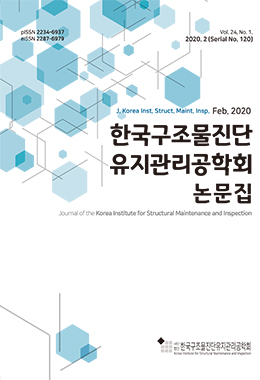원전콘크리트는 두꺼운 벽체를 가진 매스콘크리트 구조이며 시공초기에 건조수축 및 수화열에 따른 균열이 발생하기 쉽다. 또한 냉각수를 항상 필요로 하므로 해안가에 위치하는데, 균열이 발생한 콘크리트에서는 염화물 이온의 유입으로 인해 철근 부식이 빠르게 발생한다. 본 연구에서는 6000 psi 급 고강도 원전콘크리트 배합을 이용하여 재령 및 균열에 따른 확산계수의 변화를 분석하였다. 이를 위해 재령 56일, 180일, 365일 동안 양생된 콘크리트에 균열폭을 0.0∼1.4 mm까지 유도하였으며 정상상태의 촉진 확산실험을 수행하였다. 균열폭의 증가에 따라 확산계수는 최대 2.7∼3.1배로 증가하였으며, 재령의 증가에 따른 확산계수의 저감성이 크게 평가되었다. 또한 180일 동안 비말대에 노출된 균열부 콘크리트에 대하여 겉보기 확산계수 및 표면염화물량을 평가하였으며, 촉진 실험결과와 비교를 수행하였다.
Concrete structure for nuclear power plant is mass concrete structure with large wall depth and easily permits cracking in early age due to hydration heat and drying shrinkage. It always needs cooling water so that usually located near to sea shore. The crack on concrete surface permits rapid chloride intrusion and also causes more rapid corrosion in the steel. In the study, the effect of age and crack width on chloride diffusion is evaluated for the concrete for nuclear power plant with 6000 psi strength. For the work, various crack widths with 0.0~1.4 mm are induced and accelerated diffusion test is performed for concrete with 56 days, 180days, and 365 days. With increasing crack width over 1.0mm, diffusion coefficient is enlarged to 2.7~3.1 times and significant reduction of diffusion is evaluated due to age effect. Furthermore, apparent diffusion coefficient and surface chloride content are evaluated for the concrete with various crack width exposed to atmospheric zone with salt spraying at the age of 180 days. The results are also analyzed with those from accelerated diffusion test.




